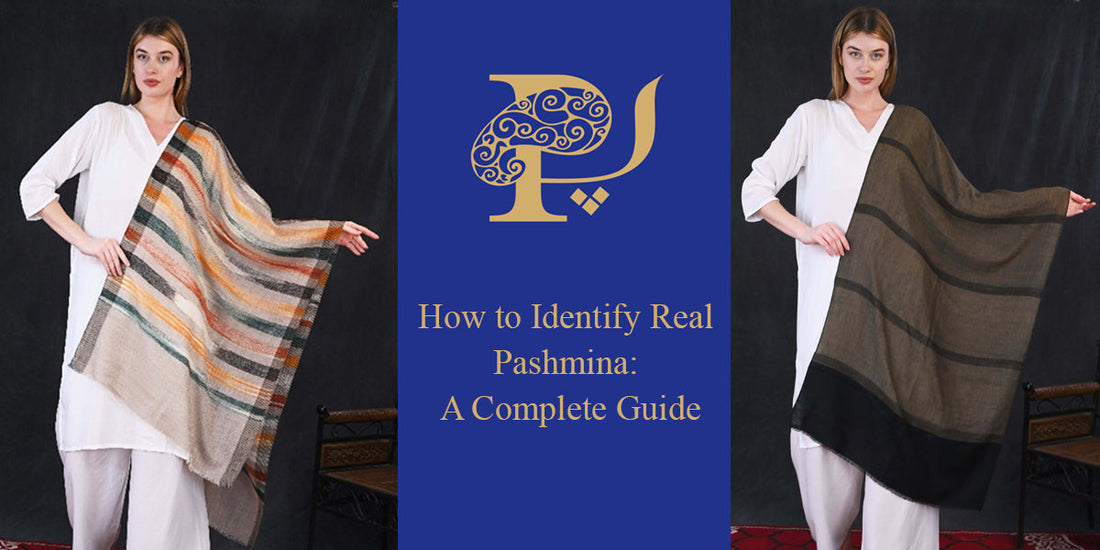
How to Identify Real Pashmina: A Complete Guide
Share
Pashmina has long been celebrated as the "soft gold" of India — a timeless fabric that has adorned royalty, symbolized luxury, and warmed generations. But with rising demand, the market today is flooded with imitations that look similar but lack the authenticity, feel, and warmth of a true Pashmina.
At PashminaParadise, we are passionate about preserving the legacy of authentic Kashmiri Pashmina, and this guide will help you understand how to spot the real from the fake.
What is Real Pashmina?
True Pashmina comes from the Changthangi goat, native to the high-altitude regions of Ladakh. The wool is hand-combed (not sheared), spun manually, and woven with precision by Kashmiri artisans who pass down this skill through generations.
This ancient process creates a pashmina shawl or stole that is:
- Featherlight
- Exceptionally warm
- Soft and luxurious to the touch
That’s the legacy we continue at PashminaParadise.
5 Ways to Identify Real Pashmina
1. The Touch Test
Real Pashmina feels soft — not silky or synthetic. It should be lightweight and warm when you wrap it around your shoulders.
➡️ Fake Pashmina often feels slippery or overly smooth, made of viscose or polyester blends.
At PashminaParadise, every product is hand-checked for the natural, warm touch that defines real Pashmina.
2. The Weave Inspection
Real Pashmina is handwoven and may show minor irregularities in the weave, a beautiful sign of artisan work. No two pieces are exactly the same.
➡️ Machine-made fakes look perfect, which is actually a red flag.
You can spot the soul of true craftsmanship in our handmade collection at PashminaParadise.
3. The Burn Test (for Experts Only)
If you’re testing a small thread:
· Real Pashmina smells like burning hair.
· It leaves a powdery ash.
· Synthetic ones melt and smell like plastic.
Of course, we don’t recommend burning your stole — just trust certified platforms like PashminaParadise, which source directly from Kashmir.
4. The Price Point
Real Pashmina is never cheap. The material is rare, labor-intensive, and time-consuming to produce.
➡️ If you see a "Pashmina" stole for ₹1000, it's most likely not genuine.
PashminaParadise ensures fair wages to artisans and premium quality, which reflects in the price — but also in durability and heritage.
5. Check for Certification & Source
Brands that care about authenticity will be transparent about:
· Source of wool (Changthangi goats)
· Location of weaving (Kashmir)
· Artisan involvement
PashminaParadise works directly with Kashmiri weavers and offers complete transparency about the origin and crafting process of each product.
Bonus Tips to Spot Fake Pashmina
· Fake Pashmina often lacks warmth despite its thickness.
· Real Pashmina becomes softer over time with use.
· Authentic pieces often have hand-tied fringes.
Where to Buy Authentic Pashmina?
To avoid imitations and support real artisans, always buy from trusted sources that are transparent about their supply chain and crafting methods.
At PashminaParadise, we take pride in offering:
✅ Certified 100% Authentic Pashmina
🧵 Handwoven by Kashmiri artisans
🌿 Ethically sourced and fairly priced
Whether you’re looking for a statement shawl, a subtle stole, or a breezy summer kaftan, we invite you to explore our exclusive Pashmina collection today.
Final Thoughts
Owning a real Pashmina is not just a fashion choice — it’s a connection to heritage, to sustainability, and to skilled craftsmanship. Now that you know how to identify real Pashmina, shop mindfully and choose platforms like PashminaParadise that honor tradition and quality over shortcuts.
🔗 Explore the legacy. Wear the story. Shop now at PashminaParadise.com
